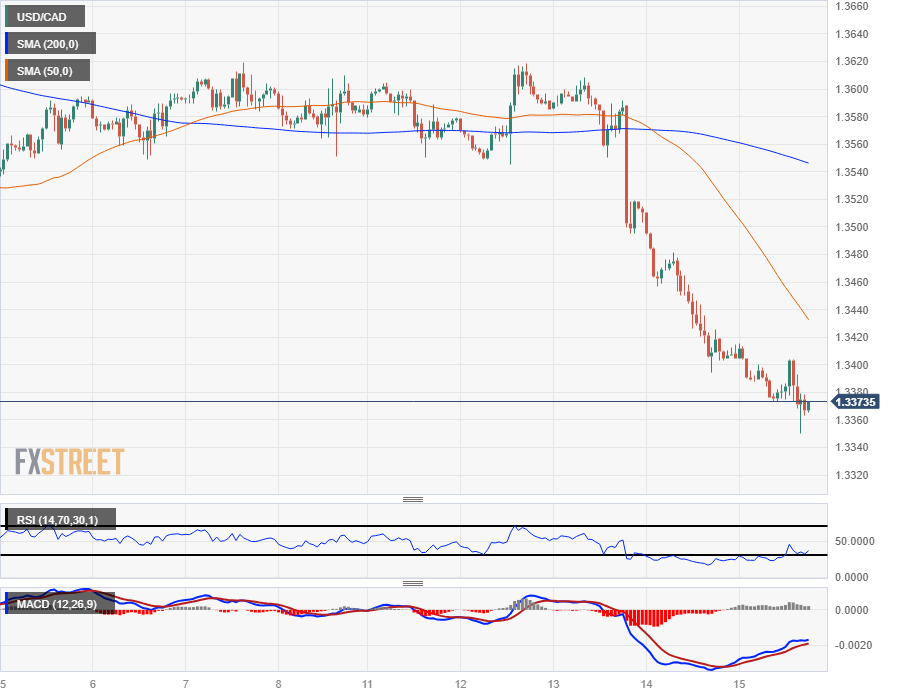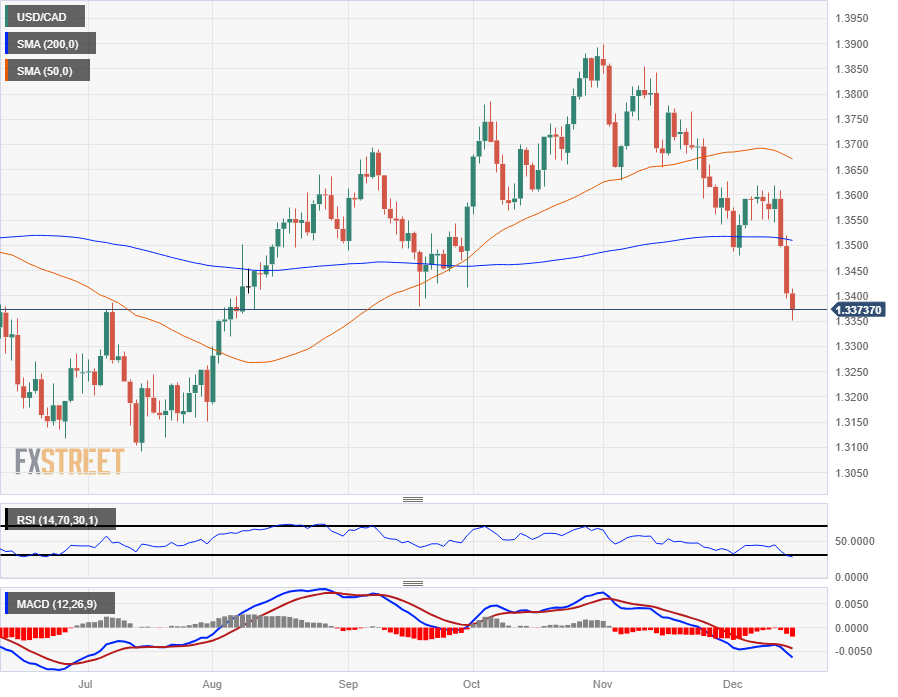Canadian Dollar ekes out further gains after mixed US data, follow-up Fed comments

- The Canadian Dollar has slowed recent gains but tests into the high side.
- Bank of Canada Governor Macklem due to make an appearance to round out the week.
- Crude Oil bids have deflated in the American trading session as Fed comments cool market rate cut hopes.
The Canadian Dollar (CAD) has paused near the top end of the week’s chart action as market participants digest updated comments from Federal Reserve (Fed) officials strongly suggesting that market expectations may have run far ahead of the Fed’s expectations of rate cuts in 2024.
Bank of Canada (BoC) Governor Tiff Macklem spoke at the Canadian Club of Toronto, where the BoC head delivered prepared notes, stating that it’s still far too early to begin considering or discussing rate cuts. BoC Governor Macklem’s appearance marks the most (if not only) noteworthy item on the CAD’s entire economic calendar for this week.
New York Fed President John Williams splashed some cold water on hot markets Friday morning, noting that market expectations of rate cuts as soon as March are “premature” The NY Fed President revealed that discussions of rate cuts haven’t even been tabled at the Fed yet.
Daily Digest Market Movers: Canadian Dollar on the high side but gains slow
- The Canadian Dollar was one of the best performers on Friday, gaining ground against all of its major currency peers.
- The CAD is up a full percent against the Euro (EUR), seven-tenths of a percent against the Pound Sterling (GBP), and a quarter of a percent against the US Dollar (USD).
- BoC Macklem: It’s still too early to consider cutting our policy rate
- NY Fed President Williams: rate cuts aren’t being discussed yet at the Fed, market expectations of rate cuts, specifically when and how much, are “premature”; Fed is “at or near” the right place in terms of policy.
- Fed Williams’ comments caused markets to stumble after this week’s bidding frenzy following adjustments to the Fed’s dot plot of interest rate expectations, with Fed policymakers now expecting around three rate cuts for 75 basis points in 2024.
- US economic calendar figures skewed to the downside on Friday, with the NY Empire State Manufacturing Index declining unexpectedly from 9.1 to -14.5 in December, falling far past market forecasts of 2.0.
- US Industrial Production for November likewise missed the mark, rebounding to 0,2% versus the forecast 0.3%, and October’s print was also revised downwards from -0.6% to -0.8%.
- The US S&P Global Purchasing Managers’ Index (PMI) prints came in mixed, with the Manufacturing component declining from 49.4 to 48.2 MoM (forecast: 49.3), steepening a decline into contraction territory.
- The US Services PMI for December surprised to the upside, coming in at 51.3 versus November’s 50.8; markets were forecast a slight move down to 50.6.
- Crude Oil markets, always looking for a reason to dump, were knocked back after Fed Williams’ appearance on CNBC, pulled WTI down towards $70.50 before stabilizing beneath $72 per barrel, limiting CAD support on Friday.
- The Canadian Dollar heads through Friday’s last market session on the top side against the US Dollar for the week, in the green 1.7% against the Greenback from Monday’s opening bids.
Canadian Dollar price today
The table below shows the percentage change of Canadian Dollar (CAD) against listed major currencies today. Canadian Dollar was the strongest against the Euro.
| USD | EUR | GBP | CAD | AUD | JPY | NZD | CHF | |
| USD | 0.75% | 0.52% | -0.31% | -0.10% | -0.19% | -0.02% | 0.15% | |
| EUR | -0.79% | -0.23% | -1.06% | -0.89% | -0.93% | -0.82% | -0.62% | |
| GBP | -0.53% | 0.24% | -0.82% | -0.64% | -0.69% | -0.58% | -0.37% | |
| CAD | 0.28% | 1.04% | 0.79% | 0.18% | 0.12% | 0.23% | 0.44% | |
| AUD | 0.10% | 0.87% | 0.62% | -0.19% | -0.06% | 0.06% | 0.26% | |
| JPY | 0.20% | 0.93% | 0.70% | -0.13% | 0.07% | 0.09% | 0.31% | |
| NZD | 0.06% | 0.78% | 0.55% | -0.28% | -0.10% | -0.17% | 0.19% | |
| CHF | -0.16% | 0.61% | 0.38% | -0.44% | -0.27% | -0.31% | -0.20% |
The heat map shows percentage changes of major currencies against each other. The base currency is picked from the left column, while the quote currency is picked from the top row. For example, if you pick the Euro from the left column and move along the horizontal line to the Japanese Yen, the percentage change displayed in the box will represent EUR (base)/JPY (quote).
Technical Analysis: Canadian Dollar on a cautious note but drifting higher against the Greenback
The Canadian Dollar is drifting into the high side against the US Dollar on Friday, squeezing out some last-minute gains before the markets wrap up the trading week.
USD/CAD spent most of Friday drifting between 1.3400 and 1.3380 before settling down towards 1.3350, and the pair is down nearly two percent peak-to-trough from the week’s high bids near 1.3620.
Friday’s continued breakdown from the 1.3400 handle has the USD/CAD setting 17-week lows, setting the pair up for a challenge of July’s lows near 1.3100 as long as selling pressure holds.
A third straight day of hard declines has the USD/CAD facing its worst three-day performance since early 2020 when the pair shed nearly 500 pips in a single half-week.
USD/CAD Hourly Chart
USD/CAD Daily Chart

Interest rates FAQs
Interest rates are charged by financial institutions on loans to borrowers and are paid as interest to savers and depositors. They are influenced by base lending rates, which are set by central banks in response to changes in the economy. Central banks normally have a mandate to ensure price stability, which in most cases means targeting a core inflation rate of around 2%.
If inflation falls below target the central bank may cut base lending rates, with a view to stimulating lending and boosting the economy. If inflation rises substantially above 2% it normally results in the central bank raising base lending rates in an attempt to lower inflation.
Higher interest rates generally help strengthen a country’s currency as they make it a more attractive place for global investors to park their money.
Higher interest rates overall weigh on the price of Gold because they increase the opportunity cost of holding Gold instead of investing in an interest-bearing asset or placing cash in the bank.
If interest rates are high that usually pushes up the price of the US Dollar (USD), and since Gold is priced in Dollars, this has the effect of lowering the price of Gold.
The Fed funds rate is the overnight rate at which US banks lend to each other. It is the oft-quoted headline rate set by the Federal Reserve at its FOMC meetings. It is set as a range, for example 4.75%-5.00%, though the upper limit (in that case 5.00%) is the quoted figure.
Market expectations for future Fed funds rate are tracked by the CME FedWatch tool, which shapes how many financial markets behave in anticipation of future Federal Reserve monetary policy decisions.
